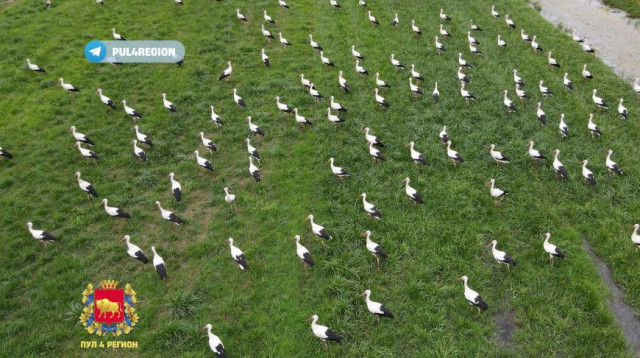Scientist explains why over 1,500 storks gather in one place near Grodno

24.07.2024
Head of the ornithology laboratory of the Center for Bioresources of the National Academy of Sciences of Belarus, Candidate of Biological Sciences Irina Samusenko told BelTA about possible reasons why 1,500 storks gathered in one place in Grodno Oblast.
A large congregation of storks was spotted in a field near Grodno. Two years ago, about two hundred birds were seen at the same place. Irina Samusenko explained what could be the reason for such a big concentration of birds. “These flocks might include young birds born last year or two years ago, since storks start breeding, nesting and hatching in the third or fourth year of life and even later. There may also be birds that failed to nest, including those that started nesting, but lost clutches or chicks, etc.,” said Irina Samusenko.

According to the scientist, such big flocks are most often observed on the farmland, specifically after the land is plowed or crops are harvested, or grass is cut, in other words, in places where birds can easily find food. Flocks of several hundred storks can be observed from the end of July and throughout August. Irina Samusenko noted that such clusters are not exceptional, yet, they are not very common, either.
Commenting on the fact that the birds congregated in the same place for the second year in a row, Irina Samusenko said: “Scientists and locals have long observed that storks choose certain locations using certain signs that only they know. This can be a combine harvester that is cutting grass or plowing the land. A very interesting study was published three years ago. It said that storks can smell places where grass is cut. It was believed before that their olfactory receptors were not that good. The latest study proves it wrong,” the scientist remarked. “We monitor storks, including in such uncommon places as landfills, dump sites. We see that unlike many other birds, storks pick protein-rich food on landfills. They don’t consume everything, they look for pieces of meat, leftovers of other human food, or industrial food waste with the help of taste buds, not just eyes.”

Irina Samusenko added that storks are nomadic birds: they don't stay longer than a week or two or even two days in one place as they constantly move from one place to another in search of food. The scientist also noted that storks are very attached to their nesting areas. “Most adult storks nest within less than 70 kilometers from their ancestral nest. They have a strong feeling of home, but all birds flying off from one nest cannot nest in the same parental nest at the same time,” she said.
Screenshots of the video of the Telegram channel Pul 4 Region

